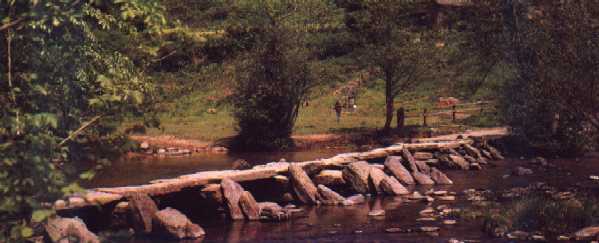|
|
|
Tarr Steps on Exmoor is difficult to get to but well worth a visit. Not much is known about the clapper bridge, only that is was thought to be prehistoric dating from about 1000BC. It has 15 arches across the River Barle and some chunks of stone weigh up to 5 tons. It has been swept away by floodwaters several times but always rebuilt.
The story goes that it was built in one night by the Devil after a local giant had challenged him to a strength contest.

|
Caratacus Stone is on the footpath to the steps and who Caratacus was is long since forgotten, but it has been estimated that the stone is a 5th century Celtic stone and was once rather important. |

Where Walla Brook and the North Teign River join there is a holed stone in the bed of the stream. If you crawl through the hole, pretty difficult if the rivers running fast, it is supposed to cure rheumatism. It is known as a Tolmen stone
![]()
Lynmouth was once noted for the particularly large catches of herrings that its fishermen would bring home. Then in 1823 the herrings deserted the area, a phenomenon which has a choice of local explanations. Some say it was because the local church was extracting a herring tithe from the locals, a particular unpopular tax. The herring apparently couldn’t bear to be the cause of such contention. Another version is that, because there were more herrings that could be eaten or sold they were used as manure on the land – insulted the herring departed, never to return.
![]()
At Meavy, near Yelverton there is an 800-year-old oak tree. It is said that 9 men once dined in here and in ancient times it was a 'dancing' tree, where pagans performed their rites and dances.
![]()
There is said to be a cave behind a rockwall at Abbot's Weir, on the River Tavy at Tavistock. The abbot dreamed about it and then went to find it. When he struck the rock with his staff the cave was revealed with all its treasures. After dark he loaded as much as he could onto his mule, climbed on and set off back to the Abbey. But the animal objected to all the extra weight and tossed both the treasure and the abbot into the weir where he drowned.
![]()
|
In the grounds of Berry Pomeroy castle there is a tree known as the wishing tree. It is said to grant the wish of anyone who walks around it three times backwards. |
![]()
Lundy Island, off the North Devon coast, is reputed to be the entrance to Annwn, the Celtic version of Hades, land of the dead. This is different to Hell which is the place of punishment.
![]()
At Stoke Gabriel in Devon there is a yew tree that is over 1500 years old and unfortunately not capable of standing unaided. It is held up with props and is still growing away. |
|
![]()
The Seven Crosses
In about 1262 the Countess of Devon, Isabella de Fortibus, lived at Carisbrooke Castle but also had several other residences. While she was staying in Tiverton one day while she was out walking she met a man carrying a large basket. Hearing a whimpering noise coming from this basket she asked the man what it contained. He replied that it was just some puppies that he was going to drown in the river. After a lot of cajoling the man eventually opened the basket revealing 7 baby boys. His wife had given birth to all seven at once and the tailor couldn't afford to feed them all so he was doing what had to be done. The Countess told him to take the boys home because she would personally pay for their upbringing and education. When the boys were old enough they were sent to Buckfast Abbey and trained for the priesthood. When ordained four became rectors of the four parts of Tiverton and the other three became curates to them. They lived in perfect harmony and loved each other dearly and when they died, on the same day, were buried in the same grave at the very spot where the Countess had previously saved them. Seven crosses were placed over the grave to mark the spot but have long since disappeared.
![]()